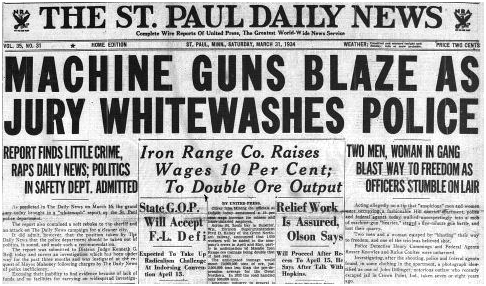John Dillinger's Great (St. Paul) Escape
Provided to the Saint Paul Police Historical Society by reporter Nick Woltman.
Originally printed in the St. Paul Pioneer Press on Friday, April 01, 2016
By Nick Woltman
nwoltman@pioneerpress.com

John Dillinger
In early 1934, a Ramsey County grand jury was tasked with looking into allegations that St. Paul's corrupt police force had allowed the city to become a haven for criminals.
It released its findings the morning of March 31.
"We believe there is no justification for any charges that an excess of crime exists here," the jurors wrote in their report.
Meanwhile, John Dillinger was shooting his way out of a Lexington Avenue apartment complex, narrowly avoiding capture by federal agents.
"MACHINE GUNS BLAZE AS JURY WHITEWASHES POLICE," screamed a banner headline on the front page of that afternoon's St. Paul Daily News.

The St. Paul Daily News; Vol. 35, No. 31
Saturday, March 31, 19341
Price Two Cents
Dillinger's escape and the manhunt that followed led the front pages of the city's newspapers for a week. It was only the latest episode in a decade-long crime wave that had plagued St. Paul facilitated by local officials who shielded criminals from prosecution in exchange for bribes.
John Dillinger, who would soon be declared Public Enemy No. 1 by FBI director J. Edgar Hoover, was rumored to be a frequent visitor.
After breaking out of an Indiana jail on March 3, Dillinger had reunited with members of his gang in the Twin Cities, writes local historian Paul Maccabee in his 1995 book "John Dillinger Slept Here." From hideouts in Minneapolis and St. Paull, Dillinger and his gang orchestrated a series of bank robberies across the Midwest.
On March 19, Dillinger and his longtime girlfriend Evelyn Frechette used fake names to rent Unit 303 at the Lincoln Court Apartments, one block south of Grand Avenue on Lexington.
But after a couple of weeks, their landlord grew suspicious – the pair always came and went through the building's back door and refused to let a maintenance worker into their apartment to repair a bathroom fixture, Maccabee writes. The landlord alerted the FBI to her tenants' strange behavior.
Two federal agents and a St. Paul police detective staked out the building on the evening of March 30, unaware that they were surveilling the most wanted criminal in the country.
The next morning, FBI agent R.C. Coulter and detective Henry Cummings knocked on the door of Apartment 303. Frechette answered, but said she needed to get dressed before speaking with them and shut the door.
Just then, Dillinger associate Homer Van Meter walked into the building and met Coulter and Cummings in the hallway. When they demanded Van Meter produce identification, he drew a pistol and started shooting.
As Coulter and Cummings returned fire, Dillinger opened his apartment door wide enough to accommodate the barrel of a Thompson submachine gun and sprayed the hallway with bullets.
"Why do these dangerous gangsters all head for St. Paul when they want to hide out from authorities or take a rest?" the Pioneer Press editorial board demanded. "Why is this city the happy hunting ground for kidnappers, thugs, thieves and machine gunners?"
The hail of gunfire sent Coulter and Cummings scrambling for cover. Dillinger, Frechette and Van Meter (who was incorrectly identified in newspaper coverage as John Hamilton, another member of Dillinger's gang) escaped. Only Dillinger was wounded in the exchange, taking a bullet in the leg.
Less than an hour later, the grand jury submitted its report declaring that St. Paul did not have a serious crime problem. The irony did not escape the city's newspapers, which had been calling for civic reform.
"Why do these dangerous gangsters all head for St. Paul when they want to hide out from authorities or take a rest?" the Pioneer Press editorial board demanded. "Why is this city the happy hunting ground for kidnappers, thugs, thieves and machine gunners?"
The Pioneer Press and Dispatch launched a fundraising campaign to buy better weapons for the city's police force, which was still using revolvers to shoot it out with machine gun-toting gangsters. They raised more than $1,800, which the department used to buy a handful of Thompsons.
As for Dillinger, his criminal career was almost over. Four months after his shootout in St. Paul, Public Enemy No. 1 was gunned down by federal agents outside a movie theater in Chicago.
1 Available via microfilm at the St. Paul Public Library and/or the Minnesota History Center.
"The St. Paul Daily News" article & John Dillinger photo was inserted by
SPPHS member Ed Steenberg.
